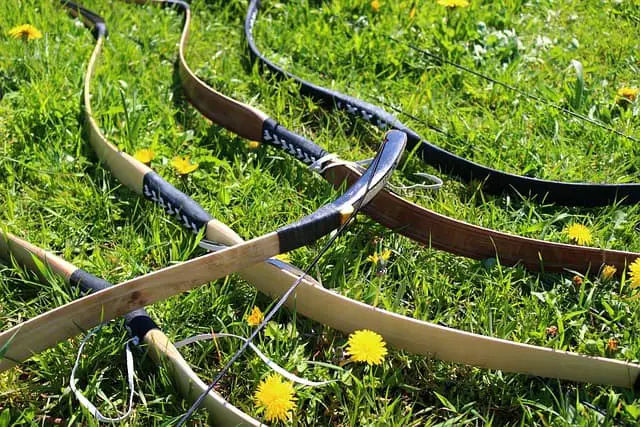While modern archery bows are typically made from fiberglass, carbon fiber, aluminum and synthetic materials, they were traditionally made from wood.
Traditional bows, such as longbows and recurve bows, are often made to this day from different types of wood, such as yew, hickory, osange orange, maple, or bamboo.
While modern bows are designed with a number of different materials to choose from as we’ll see in a moment, you do have options for wood bows if you so desire.
Below, we’ll discuss why longbows and recurve bows are still made from wood and the pros and cons of wood bows compared to other materials.
Why Longbows And Recurve Bows Are Still Made With Wood
A longbow is a traditional bow with a simple design characterized by its long, curved shape. It has a straight limb from end to end, and when unstrung, it forms a “D” shape. A recurve bow, on the other hand, has limbs that curve away from the archer when unstrung, which increases the power and speed of the arrow.
Both longbows and recurve bows are often made with wood due to its favorable properties. Wood provides a good balance of strength, flexibility, and durability, making it suitable for creating bows with efficient power transfer and accuracy.
Additionally, wood offers a natural and traditional aesthetic appeal.
Woods Used For Longbows and Recurve Bows
Various types of wood can be used for longbows and recurve bows, with different woods offering unique characteristics. Some common woods used for longbows include yew, hickory, osage orange, and bamboo. Yew is favored for its excellent combination of strength, flexibility, and ability to store and release energy efficiently. Osage orange is known for its resilience and stability. Bamboo is valued for its light weight and fast growth rate.
For recurve bows, materials such as maple, fiberglass, and carbon laminates are often used in combination. Maple provides a good balance of strength and flexibility, while fiberglass and carbon laminates add reinforcement and increase the bow’s power and performance.
Overall, wood is chosen for longbows and recurve bows because it offers the desired characteristics of strength, flexibility, and natural beauty, contributing to the overall performance and aesthetics of these traditional archery bows.
Benefits Of Each Type Of Wood Commonly Used In Wooden Bows
| Wood | Characteristics | Advantages | Disadvantages |
|---|---|---|---|
| Yew | High strength and flexibility | Efficient power transfer | Limited availability, higher cost |
| Hickory | Good strength and durability | Lower cost compared to other woods | Can be heavy and less flexible |
| Osage Orange | Resilient and stable | High energy efficiency | Limited availability, prone to checking |
| Maple | Balance of strength and flexibility | Wide availability, affordable | Less traditional look compared to yew |
| Bamboo | Lightweight and fast-growing | High strength-to-weight ratio | Requires lamination for optimal performance |
Bamboo isn’t a wood per se but is often discussed in the same way which is why it’s included here.
Please note that the advantages and disadvantages may vary depending on specific factors such as bow design, personal preferences, and the specific characteristics of the wood used.
Comparison Of Wood Bows Against Other Designs
Here’s a comparison table of different archery bow materials and how they stack up to one another:
| Material | Strengths | Weaknesses | Cost | Weight | Durability | Availability |
|---|---|---|---|---|---|---|
| Wood | Classic look, natural feel | Prone to warping and weathering | Varies | Moderate to Heavy | Moderate | Widely Available |
| Fiberglass | Durable, resistant to warping | Heavier compared to other materials | Affordable | Moderate | High | Widely Available |
| Carbon Fiber | Lightweight, high strength | Expensive | Expensive | Lightweight | High | Widely Available |
| Aluminum | Stiff, consistent performance | Less traditional aesthetic | Moderate to Expensive | Lightweight | High | Widely Available |
| Synthetic | Versatile, customizable | May lack the traditional feel | Varies | Varies | Varies | Widely Available |
Please note that the cost, weight, durability, and availability can vary based on specific brands, models, and configurations within each material category. It’s always recommended to research and consult with archery experts or manufacturers to find the best material that suits your preferences and requirements.
Summary Of Materials Used For Archery Bows
Archery bows can be made from various materials, including:
- Wood: Traditional bows, such as longbows and recurve bows, are often made from different types of wood, such as yew, hickory, osage orange, maple, or bamboo.
- Fiberglass: Modern recurve bows commonly feature limbs made from fiberglass, which provides strength and flexibility.
- Carbon Fiber: High-performance compound bows often incorporate carbon fiber components for their lightweight and durable properties.
- Aluminum: Some recurve and compound bows utilize aluminum for their risers (handles) and limbs, offering stability and durability.
- Synthetic Materials: Bows may also incorporate synthetic materials like laminates, composites, or polymers to enhance strength, stability, and performance.
It’s worth noting that the materials used can vary depending on the type of bow, the archer’s skill level, and the intended purpose of the bow.

